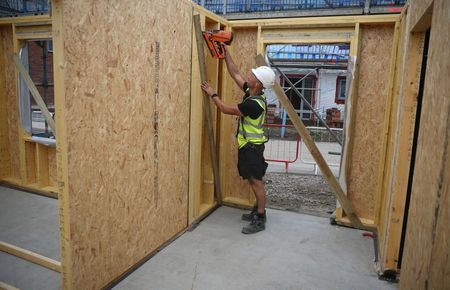By Suban Abdulla
LONDON (Reuters) -Gigantic robot arms controlled by artificial intelligence glide around a vast factory in Oxfordshire, England, making building frames from timber, one of the world’s oldest construction materials.
With the British government committed to building 300,000 new homes a year, some housebuilders say that the combination of technology and green materials could help them to overcome challenges from skills shortages to environmental targets.
England lags many similar economies in terms of the share of housing accounted for by timber-framed homes. Britain as a whole, meanwhile, is among the slowest adopters of robotics, especially in construction, according to the National Robotarium research institute at Heriot-Watt University.
“We’re seeing more major housebuilders and small and medium-sized builders embracing timber as a way to … overcome the skills and carbon challenge,” said Alex Goodfellow, CEO of Donaldson Timber Systems (DTS).
His business makes timber-frame structures for homes and commercial buildings, including walls, floors and roofs, then sends them to housebuilders for assembly.
Its automated production makes for less labour-intensive housebuilding and provides a faster, cheaper and more sustainable alternative to bricks, stone or concrete blocks, the company says.
A study by construction surveyors and consultancy Rider Levett Bucknall showed that building with timber is 2.8% cheaper than with masonry.
FASTER CONSTRUCTION
The DTS factory in Witney, near Oxford in southeast England, makes timber panelling for about 100 homes a week with designs entered digitally using artificial intelligence, reducing the need for paper drawings.
DTS says its robotics and lasers enable it to produce pre-assembled sections builders can put together quickly on site. The technology reduces the time needed to build a home by about 10 weeks compared with traditional materials, Goodfellow says.
Yet barriers remain to any significant increase in timber homes in England.
Amit Patel at the Royal Institution of Chartered Surveyors said the material is not commonly used in England because of difficulties in securing warranties for timber buildings owing to durability concerns.
Barratt Homes tried to revive timber usage in the 1980s, but sales were undermined by potential rot and fire vulnerabilities.
Andrew Orriss of the Structural Timber Association says that such concerns have been addressed by current building regulation and the STA’s fire safety guide.
He says that the off-site timber construction sector could help to deliver about a third of the government’s target of 300,000 new homes per year – a level not achieved in England since the 1970s.
Official government figures show that almost 200,000 new homes were built in England in 2023/24 and the Structural Timber Association said that approximately 40,500 of those were timber-frame homes.
Builders including Vistry and Taylor Wimpey have opened or plan to open their own timber-frame manufacturing factory while Bellway plans to use timber in a third of its housing projects by 2030.
Reduced environmental impact is another benefit touted by companies.
GREENER AND LEANER?
Simon Park, head of sustainability at Bellway, said timber absorbs and stores more carbon than it emits and that Bellway’s analysis shows breeze blocks – made from concrete and known as cinder blocks in the U.S. – are the biggest carbon emitters among common building materials.
Countering that, however, is the origin of the raw materials. About 80% of timber used in the UK is imported, mainly from European countries, while roughly 20% of its brick supply is imported.
Concerns also remain over mortgage availability for timber homes, which is likely to improve if the government signals a move towards timber construction, said Riz Malik, mortgage broker at independent financial adviser R3 Wealth.
An ageing workforce, meanwhile, highlights the need for more robotics. About a fifth of construction workers in the UK are over 50, according to the Home Builders Federation, with 25% of those set to retire in the coming decade.
The government pledged 40 million pounds ($54 million) in June for robotics adoption hubs across various sectors, but Maurice van Sante, senior economist for construction at bank ING, says Britain’s construction industry is far behind other countries in robotics use.
ING estimates that there were 1.5 robots for every 10,000 construction workers in Europe in 2023, against 0.6 in the U.S. and 0.5 in the UK.
As well as filling labour shortages directly, robotics opens up other employment opportunities, says DTS manufacturing director Frank O’Reilly, adding that the company has attracted more interest from tech-savvy younger workers since the factory’s introduction of automation and robotics.
“It (the technology) encourages young people to consider this as a career,” he said.
($1 = 0.7433 pounds)
(Reporting by Suban AbdullaEditing by David Goodman)












